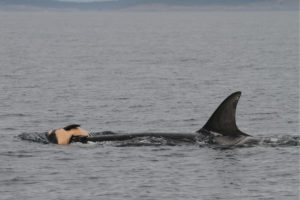
A mother orca carries her dead newborn. Several species of whales show signs of mourning. PHOTOGRAPH BY ROBIN W. BAIRD, CASCADIA RESEARCH
A mother orca whale made international news recently when, after delivering a calf on July 25th that lived only a half an hour, she began a funeral procession that lasted more than two weeks. There hadn’t been a live birth in her pod for three years and scientists have become concerned that this generation of whales may be the last.
Rather than letting her dead calf sink to the bottom of the Pacific, this mother killer whale balanced it on her head and pushed the 400-pound baby along as she followed her pod for over two weeks. This action was not unheard of, but researchers soon realized that the length of time she traveled with the calf was an unprecedented period of mourning.
She gained the attention of more than just scientists and inspired people, sometimes human mothers, to identify with her loss and her lack of readiness to let go of her offspring. Known as J35 or Tahlequah, sometime around the 17th day she was finally observed swimming without the calf. The Center for Whale Research’s website stated, “Her tour of grief is now over, and her behavior is remarkably frisky.”
As human mothers know, their mourning after a stillbirth or a miscarriage is often silent and lonely, their grief unknown and not shared by the larger community. And mothers mourning their children shot in the street by other kids or the police, know how easy it is for the larger community to move on and forget their outrage at the conditions that lead to their loss.
Perhaps this mother whale is providing an important model for mothers everywhere. At considerable cost to herself, Tahlequah mourned her loss long enough, and public enough for it to illicit world-wide attention to the dangers her species is facing – loss of the salmon which is their food source, contaminants to the water they swim in, and man-induced climate change. And the most reassuring part, when she finally let go, she returned to an energetic life with members of her own community.
https://www.cnn.com/2018/08/10/us/orca-whale-still-carrying-dead-baby-trnd/index.html

